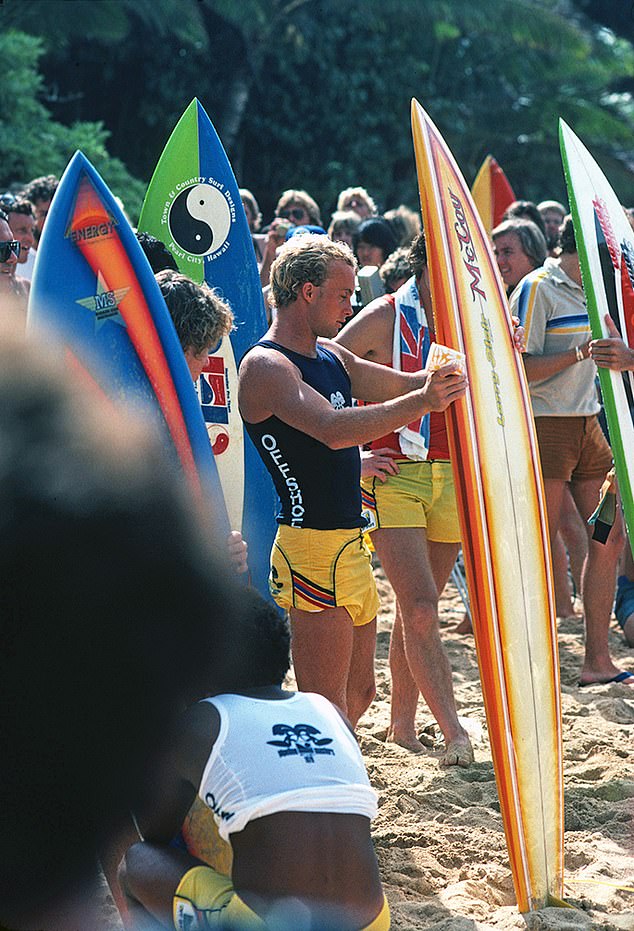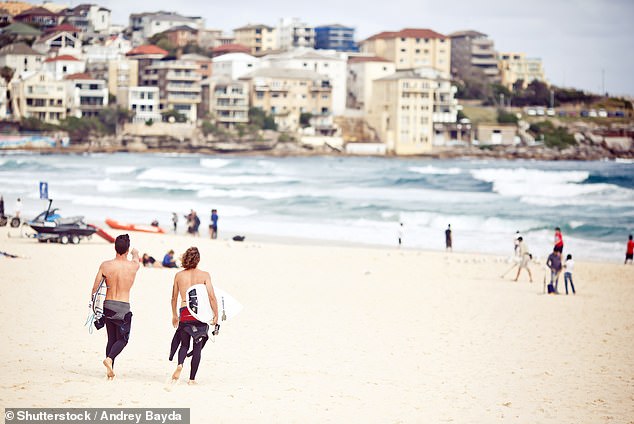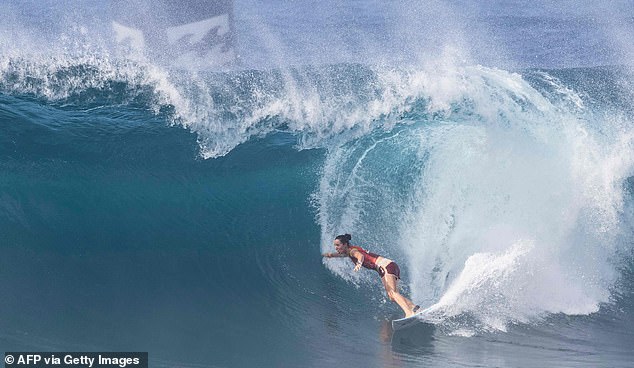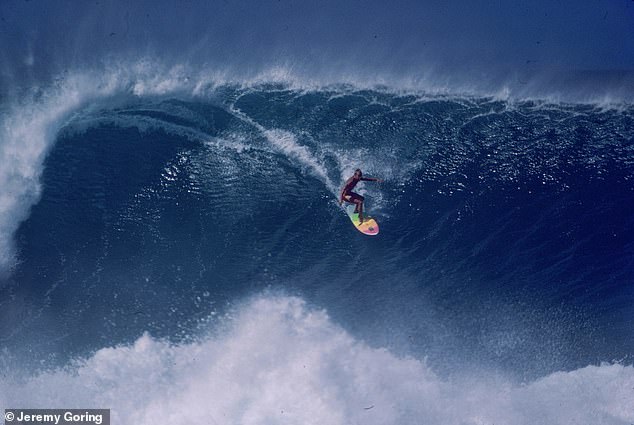How could a cocky, blonde 20-year-old Australian upstart be on the verge of winning the world’s most prestigious surfing competition: the 1978 Banzai Pipeline Masters in Hawaii?
This grueling competition takes place in “one of the most dangerous and tangled tubular bodies of water on the planet,” which has killed more surfers than all other surf spots in the world combined.
The Hawaiians, possessive of their own surfing prowess, didn’t like what they were seeing. Their jaws dropped when intrepid young Larry Blair won heat after heat, made it to the finals, and then had the audacity to win the competition, thanks to what he describes as “the extra movement, making sure to spend more time in the tighter areas.” deep and unpleasant.” tube caverns.
Reading Larry Blair’s thrilling memoir, brilliantly put to words by his friend and surfing buddy Jeremy Goring (a hotelier to the Royal Family), is in itself like riding a liquid rollercoaster.
It would be pretty exciting if it were simply about how a kid obsessed with surfing became a world champion.
The descriptions of being inside a big wave (“a liquid cathedral”) are fascinating and terrifying, and Larry’s love affair with surfing makes you understand the addictive magic of the sport.
Reading Larry Blair’s thrilling memoir, brilliantly put to words by his friend and surfing buddy Jeremy Goring (a hotelier to the Royal Family), is in itself like riding a liquid rollercoaster. In the photo: Larry Blair.

At just 19 years old, Larry won the Australian ‘Surfabout’ contest, earning him a huge cash prize. And the following year he won the Banzai Pipeline Masters in Hawaii.
But that’s only half the story. The other half is that Larry’s mother, Patricia, and stepfather, Frank ‘Baldy’ Blair, were two of Australia’s most hardened thieves, and Larry grew up as their well-trained apprentice.
His family home in Sydney “looked like Harrods or Saks Fifth Avenue” – full of stolen goods. His parents would sit up all night planning their crimes: how they would “liberate” $200,000 worth of assets in their next heist.
Young Larry knew no other way of life. His parents dressed him in silk and cashmere. He gratefully accepted ill-gotten gifts from Frank (‘a gnarled bundle of scar tissue’ whom he calls ‘Dad’), one of which was a 7-foot, 6-inch red, spear-shaped surfboard: ‘ To this day, the best thing I’ve ever had and the only inert object I’ve ever truly loved.
At first, Larry describes the criminal underworld in which he grew up as a lot of fun: his effervescent mother’s “good looks, brilliant directness, wit and cunning made her especially good at robbery”, and she often invited Larry to help her in the business. art of distraction. But the crimes became more audacious.
Frank’s armed gang began attacking banks and “anywhere where a gun could be pointed at someone.” Then, aged 12, Larry overheard them planning the biggest armed robbery in Australian history: an armored van carrying cash.
Taking drivers by surprise at gunpoint when their truck door was open during lunchtime, Frank and his gang fled with more than half a million dollars in cash. “The most expensive lunch break in the world,” blared the headlines.
After hiding the cash in the ceiling of a betting shop, Frank took the family to a Chinese banquet. Then they had to hide in the desert for a while.
Frank is presented as a lovable, big-hearted rogue. He paid a terrible price. One of his fellow thieves turned him in and he was pursued by a gang of even more ruthless criminals known as the Toe-Cutters, who kidnapped him and cut off each of his toes, one by one, asking him where he had hidden the loot. . They then killed him and dissolved his body in a barrel of acid.

His family home in Sydney “looked like Harrods or Saks Fifth Avenue” – full of stolen goods. Pictured: Surfers at Bondi Beach in Sydney
From then on, Larry’s mother Patricia became a criminal in her own right and ran an efficient network from her home. When Larry was a teenager, she and her friend John started a scam that redirected unemployment benefit payments to fictitious accounts. Larry was involved in this. On a good week, $1,000 could be paid into his fake account.
But the police discovered them and they had to flee again, this time to the United Kingdom, where Patricia joined the British criminal network.
Larry didn’t like Britain. He decided to use his funds to buy a ticket to Hawaii, where he joined the global community of surfers, made up of disaffected viscounts, drug addicts, misfits and runaways like him.
Upon his return to Australia he was arrested and released, but the scare it caused marked the end of his criminal career and the beginning of his surfing career.
The descriptions of tower block-high Hawaiian waves in this book are unforgettable: gigantic waves of water crashing into the islands’ craggy volcanic peaks. The waves echo the storms that occurred 3,500 kilometers to the north several days ago. A slight withholding of energy at the last moment “creates a powerful final concentration of power.”
At just 19 years old, Larry won the Australian ‘Surfabout’ contest, earning him a huge cash prize. And the following year, he won the Banzai Pipeline Masters in Hawaii.
World fame went directly to his head. By his own admission, he “drank, partied, fucked and crashed cars” all over Sydney. No girlfriend could stay with him for long: he was too obsessed with surfing.
There was darkness at the heart of the competitive surfing world. “Localism,” he explains, “is one of surfing’s ugly secrets.” Larry naively let it slip in a magazine interview that he intended to earn five wins at the Pipeline Masters. That was the trigger for the locals’ revenge.

Larry didn’t like Britain. He decided to use his funds to buy a ticket to Hawaii, where he joined the global community of surfers, made up of disaffected viscounts, drug addicts, misfits and runaways like him. Pictured: Australia’s Tyler Wright takes part in Hawaii’s Banzai pipeline
On his third attempt at Banzai, in 1980, he was chased out of the waves by a gang of three or four Hawaiian surfers. “I felt like a seal being chased by killer whales.” He fell out of the competition.
“That irritating arrogance had become my Achilles heel,” he writes. “I had become a target.” He decided to leave competitive surfing for good. He made a living doing television commercials and taking on roles in soap operas before becoming a chef. He now lives happily in Bali with his wife, Nyoman.
As for her mother Patricia, in 1980, she and her friends planned and executed the most brazen jewel heist in Australian history: the Goloconda, or ‘Glonda’, diamond, which was temporarily on display in a glass case at Sydney Town Hall. They posed as diamond cleaners. Once they stole the diamond, they didn’t know what to do with it. To this day he is listed as missing.
Patricia died of a brain tumor at the age of 48. Mother and son had become equal in audacity. His robbery of the ‘Glonda’, Larry writes, was ‘the highlight of his crazy, dangerous, hilarious and absolutely incomprehensible career’. It was ‘their pipeline’.
BOOK OF THE WEEK: THE OUTSIDE, by Larry Blair and Jeremy Goring (Penguin Random House Australia £17.99, 320 pages)


